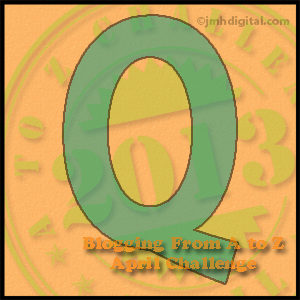 I know, you’re confused as to why the letter Q on the A-Z challenge is for ventilation-perfusion, right? Well, I was sort of confused when I learned the name of the medical test that the ventilation-perfusion was called by the docs as a V/Q scan. I get that the V is for ventilation, but what’s the Q for? Why isn’t it a V/P scan? I’m sure I could look it up, but I’m too lazy right now.
I know, you’re confused as to why the letter Q on the A-Z challenge is for ventilation-perfusion, right? Well, I was sort of confused when I learned the name of the medical test that the ventilation-perfusion was called by the docs as a V/Q scan. I get that the V is for ventilation, but what’s the Q for? Why isn’t it a V/P scan? I’m sure I could look it up, but I’m too lazy right now.
This test is an interesting test. It’s part of nuclear medicine. When I got to take this test, which I’ve had done twice now and I need done one more time at least, I have to go to the hospital and into a concrete basementy area. In this place, they have radiation detector badges, rings, and machines that check things. If they take trash out, they have to scan the trash with their machine and make sure it doesn’t beep, or they can’t take it out. If their badge or ring turns black, they aren’t allowed to work in that area any more for a specific period of time, because their exposure was too high.
That’ll unnerve you when you realize they are putting this stuff into my body! I even get a sticker after the exam saying I’m radioactive and could test positive for up to three days after the test. This is, in part, for airport security, so that if they stop someone who has traveled for medical treatment, they can get through the gates to get home.
So here’s how it works, they put an IV in to start, no problem. Then they check the IV to make sure it works. Then the first part is a breathing test. I wear a mask that seals completely around my nose and mouth. It makes breathing very difficult. You have to consciously think about taking in a big deep breath, or you’ll start breathing shallowly and feel like you’re hyperventilating. Then, they will tell me to breathe out completely as deeply and fully as I can breathe out, and then I have to breathe in for 30 full seconds, or for absolutely as long as I can, and while I’m breathing in, they are pumping a gas into the breathing mask that goes into my lungs. Then I breathe normally for about two minutes through the mask.
Then they put me in front of this machine, and I’m sitting up on a table, with the machine behind me, and behind that machine plate is another machine that puts out gamma radiation–you know, the kind that made The Incredible Hulk. Unfortunately, I don’t turn green. But don’t make me angry. You wouldn’t like me when I’m angry.
Then they scan my chest, from the back, from the front, and from each side.
The second part of the test is when they give me a radioactive isotope injection of some sort. The injection is in a metal box. The syringe has a metal box around it to protect the healthcare worker. They wear special gloves when they give it to me. If they spill it or drip it, it’s a bad thing. I have to lay down when they put this in the IV. They have to do it via IV, because if they miss the vein, bad things can happen. It is a little scary that a substance that they have to be so careful with is being injected into my body–but, you do what ya gotta do, right?
Then they repeat the scan. One of these tests is the ventilation test; one of them is the perfusion test.
The scans tell the docs whether the blood clots that are in my lungs have gotten any bigger or smaller, if new ones have developed, or if I still have striations and scars from the past blood clots. This test will confirm the diagnosis of CTEPH. They do the test every two years when I’m stable. There is a very slim, very, very slim chance, that one of these times they will do it, I will not have a ‘mismatch’. Mismatch is what confirms the CTEPH diagnosis. As long as I have a mismatch, then the pulmonary hypertension I’m experiencing is caused by CTEPH. If the mismatch is gone, then it is pulmonary hypertension from another cause. Given that CTEPH is typically terminal, and PAH, while chronic and debilitating, usually isn’t terminal (though it can cause heart failure that is terminal–but then, so does CTEPH) my hope is always that they’ll find some evidence that I don’t have CTEPH and instead of PH/PAH instead.
So I’m scheduled for another V/Q scan in June or July–I forget which and I’m too lazy to look it up. I can’t help but hope a little bit that on this scan there won’t be a mismatch. Fingers cross, good thoughts, prayers, all that jazz… if it’s still a mismatch, nothing changes, but sure would be nice if the CTEPH just miraculously disappeared!
Anyway, this is a really cool test, though it’s a little scary too. I find nuclear medicine fascinating. If nothing else, I have been radioactive for a few days of my life now! Cool, huh?
Love and stuff,
Michy